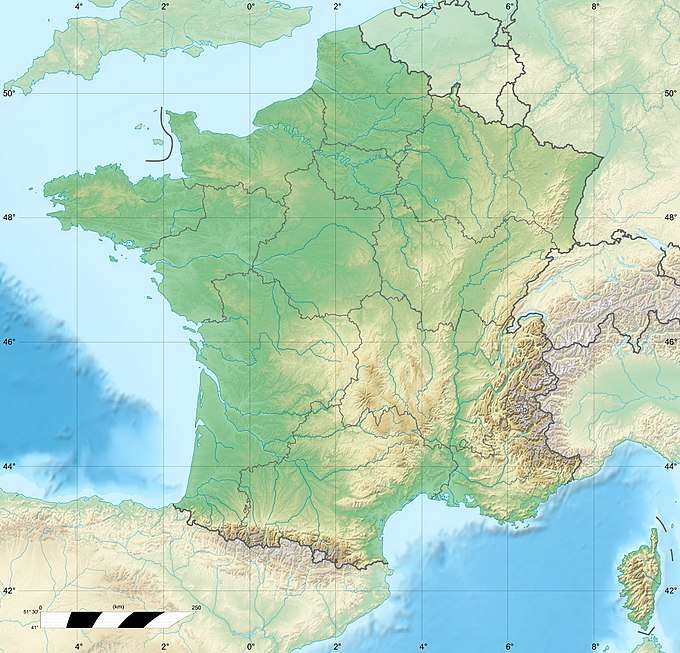Grotte du Renne
The Grotte du Renne (French for "Reindeer's cave/grotto") is one of the many caves at Arcy-sur-Cure in France, an archaeological site of the Middle/Upper Paleolithic period in the Yonne departement, Bourgogne-Franche-Comté. It contains Châtelperronian lithic industry and Neanderthal remains. Grotte du Renne has been argued to provide the best evidence that Neanderthals developed aspects of modern behaviour before contact with modern humans, but this has been challenged by radiological dates, which suggest mixing of later human artifacts with Neanderthal remains.[1][2] However, it has also been argued that the radiometric dates have been affected by post-recovery contamination, and statistical testing suggests the association between Neanderthal remains, Châtelperronian artefacts and personal ornaments is genuine, not the result of post-depositional processes.[3]
 location in France | |
| Location | caves of Arcy-sur-Cure |
|---|---|
| Region | France |
| Coordinates | 47°36′13″N 3°44′27″E |
| Type | limestone karst cave complex |
| History | |
| Periods | late Upper Paleolithic |
| Cultures | Châtelperronian |
| Associated with | Neanderthal |
Site
It has 15 archaeological levels that cover a depth of about 4 m. From top to base they are labelled I to XV. Those of V and VI are Gravettian. Level VII is Proto-Aurignacian. VIII, IX and X are Châtelperronian (42 kya). Level X contains symbolic ornaments, awls, pierced animal teeth, and ivory pendants together with dental remains of Neanderthals.
Faunal remains include reindeer and horse, and these animals are the source of some of the bone tools used at the site. Some mammoth remains are visible, interpreted by Leroi-Gourhan[4] as evidence for huts at the entrance, but this has not been substantiated.
Neanderthal behavior
Because Neanderthal remains coexist with artifacts showing complex behavior, such as personal ornaments, it has been argued that they had acquired the capacity for complex symbolic behavior associated with modern humans.
Paul Mellars notes, on the basis of new radiocarbon dating on the cave of Grotte du Renne,[1] "that there was strong possibility — if not probability — that they were stratigraphically intrusive into the Châtelperronian deposits from .. overlying Proto-Aurignacian levels" and that "The central and inescapable implication of the new dating results from the Grotte du Renne is that the single most impressive and hitherto widely cited pillar of evidence for the presence of complex “symbolic” behavior among the late Neanderthal populations in Europe has now effectively collapsed.".[2] Caron et al.[3] challenge this interpretation, arguing that the radiocarbon dates have been affected by incomplete decontamination, that there is no evidence for general displacement of artefacts between the stratigraphic layers, that the associations between Neanderthal remains and artefacts are therefore genuine, and that Grotte du Renne is complemented by evidence for similar Neanderthal behaviour from Iberian and Italian sites.
References
- Higham, Thomas; Jacobi, Roger; Julien, Michèle; David, Francine; Basell, Laura; Wood, Rachel; Davies, William; Ramsey, Christopher Bronk (2010). "Chronology of the Grotte du Renne (France) and implications for the context of ornaments and human remains within the Chatelperronian". Proc Natl Acad Sci USA. 107 (47): 20234–20239. doi:10.1073/pnas.1007963107. PMC 2996711. PMID 20956292. Retrieved June 20, 2017.
- Mellars, Paul (2010). "Neanderthal symbolism and ornament manufacture: The bursting of a bubble?". Proc Natl Acad Sci USA. 107 (47): 20147–20148. doi:10.1073/pnas.1014588107. PMC 2996706. PMID 21078972. Retrieved June 20, 2017.
- Caron, François; d'Errico, F.; Del Moral, P.; Santo, F.; Zilhão, J. (2011). "The Reality of Neandertal Symbolic Behavior at the Grotte du Renne, Arcy-sur-Cure, France". PLOS ONE. 6 (6): e21545. doi:10.1371/journal.pone.0021545. PMC 3126825. PMID 21738702. Retrieved 4 April 2014.
- Leroi-Gourhan, A. 1965. Le Châtelperronien, problème ethnologique. In Miscelanea in homenaje al Abate Henri Breuil. Barcelona: Instituto de prehistorica y arqueologia. t.2, pp. 75-81.
See also
Related articles
External links
- Frido Welker; et al. (July 29, 2016). "Palaeoproteomic evidence identifies archaic hominins associated with the Châtelperronian at the Grotte du Renne". Proceedings of the National Academy of Sciences USA. 113 (40): 11162–11167. doi:10.1073/pnas.1605834113. PMC 5056053. PMID 27638212. Retrieved June 19, 2017.